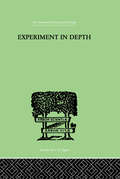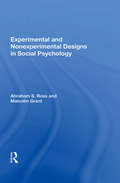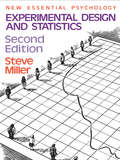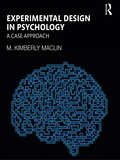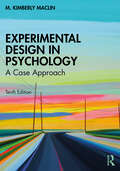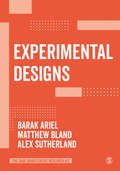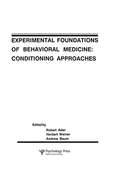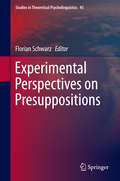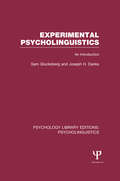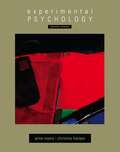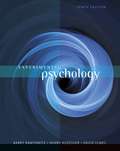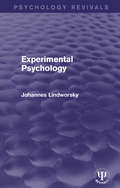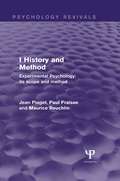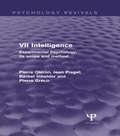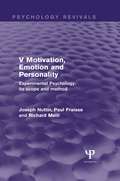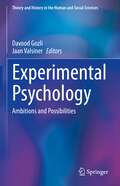- Table View
- List View
Experiment In Depth: A STUDY OF THE WORK OF JUNG, ELIOT AND TOYNBEE (International Library Of Psychology Ser.)
by Martin, P WFirst published in 1999. Routledge is an imprint of Taylor & Francis, an informa company.
Experimental And Nonexperimental Designs In Social Psychology
by Abraham S. RossThis book considers experimental designs, alternatives to experimental designs, survey methods, and how systematic collection of information can minimize alternative explanations in social psychology. It discusses meta-analysis for interpreting the results of many social psychology experiments.
Experimental Child Psychologist: Essays and Experiments in Honor of Charles C. Spiker
by Lewis P. Lipsitt and Joan H. CantorFirst Published in 1986. Routledge is an imprint of Taylor & Francis, an informa company.
Experimental Design and Statistics
by Steve MillerThe distinguishing feature of experimental psychology is not so much the nature of its theories as the methods used to test their validity. The first edition of Experimental Design and Statistics provided a clear and lucid introduction to these methods and the statistical techniques which support them. For this new edition the text has been revised, the coverage of two-sample tests has been extended, and new sections have been added introducing one-sample tests, linear regression and the product-moment correlation coefficient.Problems associated with the applications of experimental design and how to use observations of behaviour in research are key questions for all introductory students of psychology. This new and expanded edition provides them with an invaluable text and source.
Experimental Design in Psychology: A Case Approach
by M. Kimberly MacLinThis text is about doing science and the active process of reading, learning, thinking, generating ideas, designing experiments, and the logistics surrounding each step of the research process. In easy-to-read, conversational language, Kim MacLin teaches students experimental design principles and techniques using a tutorial approach in which students read, critique, and analyze over 75 actual experiments from every major area of psychology. She provides them with real-world information about how science in psychology is conducted and how they can participate. Recognizing that students come to an experimental design course with their own interests and perspectives, MacLin covers many subdisciplines of psychology throughout the text, including IO psychology, child psychology, social psychology, behavioral psychology, cognitive psychology, clinical psychology, health psychology, educational/school psychology, legal psychology, and personality psychology, among others. Part I of the text is content oriented and provides an overview of the principles of experimental design. Part II contains annotated research articles for students to read and analyze. Classic articles have been retained and 11 new ones have been added, featuring contemporary case studies, information on the Open Science movement, expanded coverage on ethics in research, and a greater focus on becoming a better writer, clarity and precision in writing, and reducing bias in language. This edition is up to date with the latest APA Publication Manual (7th edition) and includes an overview of the updated bias-free language guidelines, the use of singular "they," the new ethical compliance checklist, and other key changes in APA style. This text is essential reading for students and researchers interested in and studying experimental design in psychology.
Experimental Design in Psychology: A Case Approach
by M. Kimberly MacLinThis text is about doing science and the active process of reading, learning, thinking, generating ideas, designing experiments, and the logistics surrounding each step of the research process. In easy-to-read, conversational language, Kim MacLin teaches students experimental design principles and techniques using a tutorial approach in which students read, critique, and analyze over 75 actual experiments from every major area of psychology. She provides them with real-world information about how science in psychology is conducted and how they can participate. Recognizing that students come to an experimental design course with their own interests and perspectives, MacLin covers many subdisciplines of psychology throughout the text, including IO psychology, child psychology, social psychology, behavioral psychology, cognitive psychology, clinical psychology, health psychology, educational/school psychology, legal psychology, and personality psychology, among others. Part I of the text is content oriented and provides an overview of the principles of experimental design. Part II contains annotated research articles for students to read and analyze. New sections on how to critically evaluate media reports of scientific findings (in other words, how to identify ‘fake news’), authorship guidelines and decisions, survey research methods and AI tools have been included. Further, expanded information on the Open Science movement, and on ethics in research, and methods to achieve clarity and precision in thinking and writing are included. This edition is up to date with the latest APA Publication Manual (7th edition) and includes an overview of the bias-free language guidelines, the use of singular "they," and an ethical compliance checklist.. This text is essential reading for students and researchers interested in and studying experimental design in psychology.
Experimental Design in Psychology: A Case Approach
by M. Kimberly MacLinThis text is about doing science and the active process of reading, learning, thinking, generating ideas, designing experiments, and the logistics surrounding each step of the research process. In easy-to-read, conversational language, Kim MacLin teaches students experimental design principles and techniques using a tutorial approach in which students read, critique, and analyze over 75 actual experiments from every major area of psychology. She provides them with real-world information about how science in psychology is conducted and how they can participate.Recognizing that students come to an experimental design course with their own interests and perspectives, MacLin covers many subdisciplines of psychology throughout the text, including IO psychology, child psychology, social psychology, behavioral psychology, cognitive psychology, clinical psychology, health psychology, educational/school psychology, legal psychology, and personality psychology, among others. Part I of the text is content oriented and provides an overview of the principles of experimental design. Part II contains annotated research articles for students to read and analyze.New sections on how to critically evaluate media reports of scientific findings (in other words, how to identify ‘fake news’), authorship guidelines and decisions, survey research methods and AI tools have been included. Further, expanded information on the Open Science movement, and on ethics in research, and methods to achieve clarity and precision in thinking and writing are included.This edition is up to date with the latest APA Publication Manual (7th edition) and includes an overview of the bias-free language guidelines, the use of singular "they," and an ethical compliance checklist.. This text is essential reading for students and researchers interested in and studying experimental design in psychology.
Experimental Designs (The SAGE Quantitative Research Kit)
by Alex Sutherland Barak Ariel Matthew P. BlandThe fourth book in The SAGE Quantitative Research Kit, this resource covers the basics of designing and conducting basic experiments, outlining the various types of experimental designs available to researchers, while providing step-by-step guidance on how to conduct your own experiment. As well as an in-depth discussion of Random Controlled Trials (RCTs), this text highlights effective alternatives to this method and includes practical steps on how to successfully adopt them. Topics include: · The advantages of randomisation · How to avoid common design pitfalls that reduce the validity of experiments · How to maintain controlled settings and pilot tests · How to conduct quasi-experiments when RCTs are not an option Practical and succintly written, this book will give you the know-how and confidence needed to succeed on your quantitative research journey.
Experimental Designs (The SAGE Quantitative Research Kit)
by Alex Sutherland Barak Ariel Matthew P. BlandThe fourth book in The SAGE Quantitative Research Kit, this resource covers the basics of designing and conducting basic experiments, outlining the various types of experimental designs available to researchers, while providing step-by-step guidance on how to conduct your own experiment. As well as an in-depth discussion of Random Controlled Trials (RCTs), this text highlights effective alternatives to this method and includes practical steps on how to successfully adopt them. Topics include: · The advantages of randomisation · How to avoid common design pitfalls that reduce the validity of experiments · How to maintain controlled settings and pilot tests · How to conduct quasi-experiments when RCTs are not an option Practical and succintly written, this book will give you the know-how and confidence needed to succeed on your quantitative research journey.
Experimental Foundations of Behavioral Medicines: Conditioning Approaches (Perspectives on Behavioral Medicine Series)
by Andrew Baum Robert Ader Herbert WeinerA new attempt to acknowledge and rekindle interest in the experimental foundation of behavioral medicine, this volume focuses on the relevance of conditioning processes in the development of clinically relevant intervention strategies. It provides illustrations of the basic conditioning effects in the regulation of physiological responses, the role of conditioning in selected disease models, the precise application of conditioning principles, and speculative analyses of the potential of conditioning in the modification of clinically relevant responses. Issues involved in teaching both the fundamentals and the applied components of behavioral medicine are addressed.
Experimental Methods in Embodied Cognition: How Cognitive Psychologists Approach Embodiment
by Martin H. Fischer Arianna FelisattiExperimental Methods in Embodied Cognition presents a timely introduction to methodologies of cognitive science from a theoretical perspective. Embodied approaches to cognition are becoming increasingly prevalent in teaching and research globally, but until now a comprehensive book combining theoretical principles and practical methods for embodied cognition has been missing. Embracing this theoretical principle, the book introduces and compares different psychological methods from theoretical, technical, and methodological points of view. Informed by the direct experiences of a specialised group of authors, the text also offers a taxonomy of methods, including technical hands-on descriptions to support student learning. Each chapter includes suggestions for their use, enabling readers to compare methodologies and to find the most suitable approach for their specific research questions. Finally, the book also addresses the effects of different cultural immersions and learning experiences, offering an overview of other, non-psychological approaches to embodied cognition research, including comparative research with animals and humanoid robots. This is an essential read for students and researchers of embodied cognition across various fields, ranging from psychology and cognitive neuroscience to philosophy, linguistics, economics, and sport science.
Experimental Methods in Psychology
by Gustav Levine Stanley ParkinsonThis text focuses on the experimental methods and the associated terminology encountered in the research literature of psychology. Initially, the content is kept simple, so as not to distract from the information on research technique and philosophy. Interesting psychological questions from well researched areas are then examined in detail, permitting a fuller discussion of the problems encountered in specific paradigms. It is in this fashion that the book offers both methods and content. Unique features of this text include: * a detailed discussion of the process of theorizing, coupled with a close examination of psychological constructs, offers the reader an opportunity to see how psychologists think about, develop, and modify their theories, and the part played by research in changing explanations of behavior. * Although it is common for psychologists to be self-conscious in their reasoning, it is uncommon to see an analysis of the logic that they use to draw conclusions. Presenting material that is rarely verbalized but readily acknowledged by experienced researchers, the text contains an overt analysis of the logic of drawing conclusions from research. * Instructors are given a choice among 15 chapters to focus on or combine to suit the course's concentration. For example, instructors have the option of focusing on experimental psychology or a broad-based course including material on research methods in experimental, social, clinical, and applied psychology. * Courses in experimental psychology or research methods are required for every psychology major. Statistical understanding is vital for this curriculum, and this text contains a comprehensive chapter on statistics making it ideal for courses that combine statistics and experimental methods. Other important coverage includes: * an all-inclusive summary of the material found in an introductory statistics class. Although courses in research methods and experimental psychology usually have a statistics prerequisite, the students rarely remember the material when entering the research course. This text provides the instructor with the option of simply assigning the statistics information as a review, rather than repeating the lectures. If the course requirements are such as to necessitate a joint statistics and research methods course -- with the instructor lecturing on both topics -- this text could serve as the single text for the course. A helpful discussion -- accompanied by a valuable table -- demonstrates how to choose an appropriate statistic. All necessary formulas and other familiar statistical procedures -- illustrating computational steps -- are also featured. * a detailed discussion of how to develop tests for use in research. Aside from the value of this information for any researcher, it can be particularly helpful to students who are required to develop original experiments. * an elaborate discussion of methodological issues in outcome research, using smoking cessation and weight reduction programs as examples. Test bank disks for Experimental Methods in Psychology, -- free to adopters -- consist of an average of six short-answer, 11 fill-in-the-blank, and 11 multiple-choice questions for each chapter. The files are in both ASCII and Word-for-Windows formats.
Experimental Models in Serotonin Transporter Research
by Allan V. Kalueff Justin L. LaporteThe serotonin transporter is a key brain protein that modulates the reuptake of the neurotransmitter serotonin from synaptic spaces back into the presynaptic neuron. This control over neuronal signalling makes it a prime area of neuroscientific study. In this book an international team of top experts introduce and explicate the role of serotonin and the serotonin transporter in both human and animal brains. They demonstrate the relevance of the transporter and indeed the serotonergic system to substrates of neuropsychiatric disorders, and explain how this knowledge is translated into valid animal models that will help foster new discoveries in human neurobiology. Writing for graduate students and academic researchers, they provide a comprehensive coverage of a wide spectrum of data from animal experimentation to clinical psychiatry, creating the only book exclusively dedicated to this exciting new avenue of brain research.
Experimental Perspectives on Presuppositions
by Florian SchwarzThis volume brings together some of the most recent developments in the field of experimental pragmatics, specifically empirical approaches to theoretical issues in presupposition theory. It includes studies of the online processing of presupposed content; investigations of the interpretive properties of presuppositions in various linguistic contexts; comparative perspectives relative to other aspects of meaning, such as asserted content and implicatures; cross-linguistic comparisons of presupposition triggers; and perspectives from language acquisition. Taken together, these novel contributions provide a snapshot of state-of-the art developments in this area and will serve as a point of reference for numerous emerging avenues of future work. It makes for an ideal set of readings for advanced university courses on experimental studies of meaning and is a must-read for anyone interested in experimental research on meaning in natural language.
Experimental Psycholinguistics: An Introduction (Psychology Library Editions: Psycholinguistics)
by Sam Glucksberg Joseph H. DanksHow is speech produced and understood in the context of everyday communication? First published in 1975, this book is considered one the best of the early books in this field. The task of psycholinguistics is to discover how people produce and comprehend speech. This encompasses virtually all aspects of psychology, including perceptual, conceptual, and social processes. The authors tried to capture the flavour of this approach to the psychology of language by describing the major contemporary issues, problems, and phenomena, of the time, being dealt with in laboratories and in field studies, and by trying to make sense of the data they had. Experimental Psycholinguistics: An Introduction does not try to deal exhaustively with any one issue in linguistics or in psychology. Rather it tries to integrate the authors’ knowledge of language and language behaviour so that someone entering the field has an intelligible framework with which to start.
Experimental Psychology
by Christine H. Hansen Anne MyersFocusing on experimental methods, authors Anne Myers and Christine Hansen lead students step by step through the entire research process, from generating testable hypotheses to writing the research report. The major sections of the book parallel the major sections of a research report (Introduction, Method, Results, and Discussion), giving students the skills they'll need to design and conduct an experiment, analyze and interpret the research findings, and report those findings. Although the main focus is on experimentation, alternative approaches are discussed as important complements.
Experimental Psychology
by Henry L. Roediger Barry H. Kantowitz David G. ElmesUNDERSTANDING PSYCHOLOGY RESEARCH, Ninth Edition, takes an example-based approach to the fundamentals of research methodology. Organized by topic--such as research in human factors, learning, thinking, and problem solving--the text helps you connect the concepts of sound methodology with their practical applications. Because the authors use dozens of carefully selected real-world examples, you can see for yourself the issues and problems that can occur in conducting research. More importantly, you can develop a sense of how to anticipate and adjust for problems in your own research.
Experimental Psychology
by Henry L. Roediger Barry H. Kantowitz David G. ElmesKantowitz, Roediger, and Elmes, all prominent researchers, take an example-based approach to the fundamentals of research methodology. The book is organized by topic--such as research in human factors, learning, thinking, and problem solving--and the authors discuss and clarify research methods in the context of actual research conducted in these specific areas. This unique feature helps readers connect the concepts of sound methodology with their practical applications. Carefully selected real-world examples allow readers to see for themselves the issues and problems that can occur in conducting research. More importantly, readers develop a sense of how to anticipate and adjust for problems in their own research.
Experimental Psychology (Psychology Revivals)
by Johannes LindworskyOriginally published in German in 1923, this English edition was first published in 1931. From the translators preface: "Experimentelle Psychologie is characterized by an excellent summarizing of the most recent experimental data and by a spirit of fairness which it exhibits in organizing facts under general theoretical principles. Besides informing the reader, it stimulates him by critical remarks and suggestions for further thinking and experimentation." Today it can be read and enjoyed in its historical context.
Experimental Psychology Its Scope and Method: History and Method (Psychology Revivals)
by Jean Piaget Maurice Reuchlin Paul FraisseFirst published in English 1968, in this volume Paul Fraisse begins with history, looking at the evolution of experimental psychology, starting with its origins. He then moves on to the establishment of experimental psychology around the world. In the second chapter he discusses the experimental method. In the third chapter Jean Piaget tackles the questions of explanation and parallelism and their problems within experimental psychology. The final chapter by Maurice Reuchlin goes on to discuss measurement in psychology looking at various scales with their experimental conditions and numerical properties.
Experimental Psychology Its Scope and Method: Intelligence (Psychology Revivals)
by Jean Piaget Bärbel Inhelder Pierre Oléron Pierre GrécoFirst published in English in 1969, the book opens with a chapter by Pierre Oléron on intellectual activities. These fall into three groups: inductive activities (the apprehension of laws, relations and concepts), reasoning and problem solving. It describes typical methods and essential results obtained by relevant experiments. There are two chapters by Jean Piaget and his collaborator Bärbel Inhelder. The first, on mental images, breaks new ground: it describes original experiments carried out by Piaget and associates with children of various ages. Piaget examines the relations between images and motor activity, imitation, drawing and operations. He also classifies images according to their degree of complexity and show why children have inadequate images of some processes. The second chapter is on intellectual operations and Piaget gives a summary of the main findings of a number of his earlier books, on the child’s notions of conservation, classification, seriation, number, measurement, time, speed and chance. In the last chapter, Pierre Gréco discusses learning and intellectual structures. He describes the work of psychologists with rats in mazes and formulating theories of animal learning. Gestalt psychology and various other interpretations are examined and Greco also pays attention to Piaget’s view of ‘structural learning’ based on experience.
Experimental Psychology Its Scope and Method: Learning and Memory (Psychology Revivals)
by Jean François Le Ny Gérard de Montpellier Geneviève Oléron César FlorèsFirst published in English in 1970, the first chapter of the book is concerned with conditioned reactions. Jean François le Ny discusses ways in which conditioned reactions are acquired and the laws governing their function. The second contributor, Gérard de Montpellier, looks at different types of learning. The varying processes involved in both animal and human learning are considered, together with some general factors and mechanisms of learning. The third section of the book by Geneviève Oléron deals with the phenomenon of transfer. Among the topics included are the determination of transfer effects, transfer in perceptual-motor activities and explanations of transfer. In the final chapter, César Florès examines memory, forgetting and reminiscence. The discussion covers methodology, the influence of material, the role of practice, the part played by attitudes, motivation and emotive reactions in the memory process, as well as the importance of organisation of memory tasks on the part of the subject.
Experimental Psychology Its Scope and Method: Motivation, Emotion and Personality (Psychology Revivals)
by Joseph Nuttin Paul Fraisse Richard MeiliFirst published in English in 1968, Joseph Nuttin contributes the first chapter, on Motivation. He discusses various aspects of the motivational process. Such as incentives, conflict, social motivation, and negative motivation, and describes the mechanism of the process. The second chapter, by Paul Fraisse, is on the Emotions. Fraisse examines the nature of the emotions, both on the behavioural and on the neurophysiological levels, and goes on to define and discuss moving situations. He shows the different types of expression an emotional reaction may take, and discusses the causes of hyper-emotionality. Richard Meili writes on the Structure of the Personality, showing the importance of the idea of trait in the psychology of personality. He describes the use of the factorial method in the analysis of personality, and gives an account of the beginnings of personality, as well as the different parts, known as instances, of the total organization of personality.
Experimental Psychology and Human Agency
by Davood GozliThis book offers an analysis of experimental psychology that is embedded in a general understanding of human behavior. It provides methodological self-awareness for researchers who study and use the experimental method in psychology. The book critically reviews key research areas (e.g., rule-breaking, sense of agency, free choice, task switching, task sharing, and mind wandering), examining their scope, limits, ambiguities, and implicit theoretical commitments. Topics featured in this text include: Methods of critique in experimental research Goal hierarchies and organization of a task Rule-following and rule-breaking behavior Sense of agency Free-choice tasks Mind wandering Experimental Psychology and Human Agency will be of interest to researchers and undergraduate and graduate students in the fields of experimental psychology, cognitive psychology, theoretical psychology, and critical psychology, as well as various philosophical disciplines.
Experimental Psychology: Ambitions and Possibilities (Theory and History in the Human and Social Sciences)
by Jaan Valsiner Davood GozliThis work brings together different perspectives on psychological methods and particularly methods involving experimentation. To encourage a reflective use of research methods, the authors illuminate the historical, philosophical, and scientific dimensions of methodology, providing both defenses and criticisms of experimental psychology. The primary audience of the work are students and researchers in psychological and behavioral sciences, who have an interest in methodology
